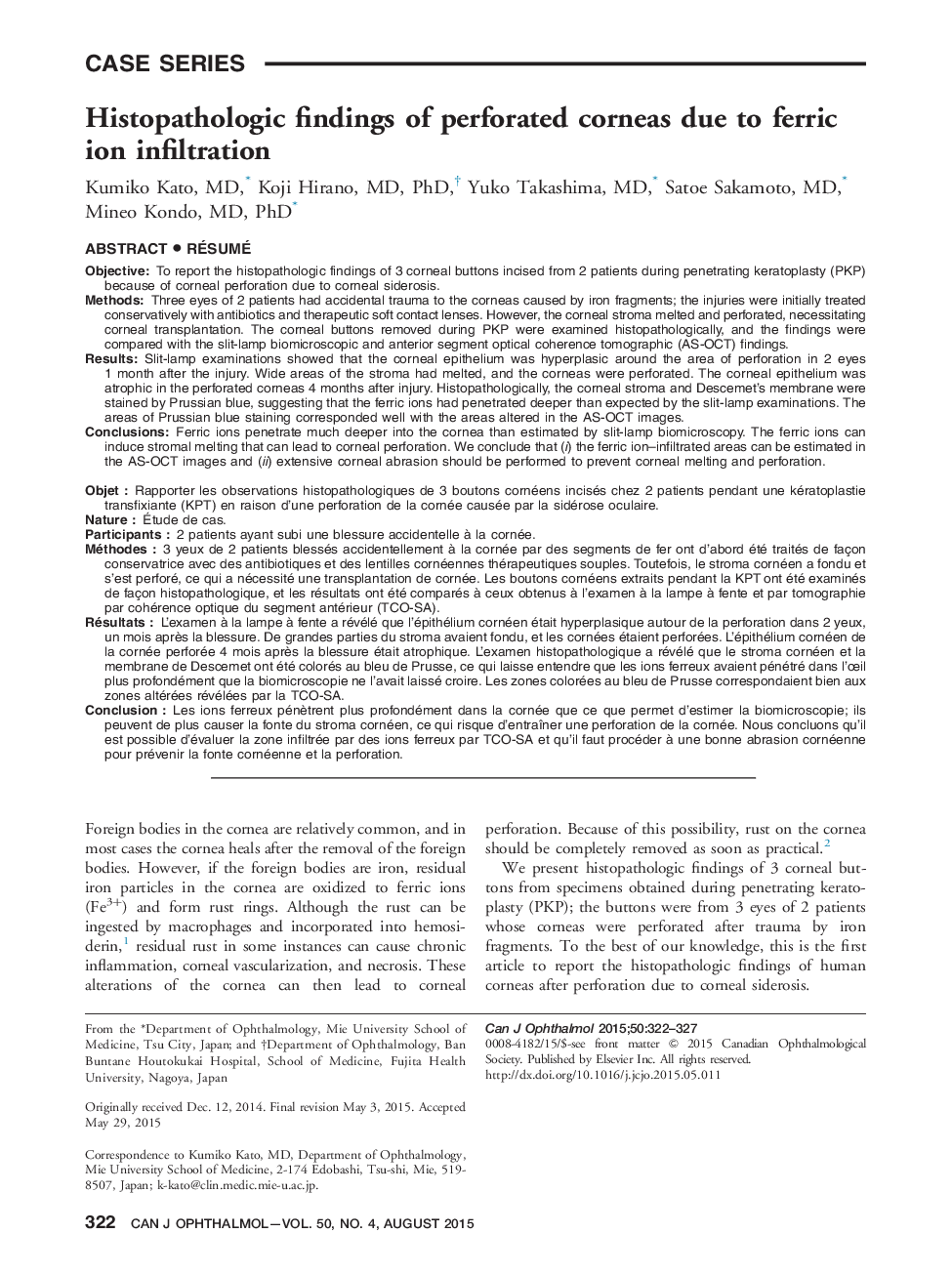| کد مقاله | کد نشریه | سال انتشار | مقاله انگلیسی | نسخه تمام متن |
|---|---|---|---|---|
| 4009065 | 1602395 | 2015 | 6 صفحه PDF | دانلود رایگان |
ObjectiveTo report the histopathologic findings of 3 corneal buttons incised from 2 patients during penetrating keratoplasty (PKP) because of corneal perforation due to corneal siderosis.MethodsThree eyes of 2 patients had accidental trauma to the corneas caused by iron fragments; the injuries were initially treated conservatively with antibiotics and therapeutic soft contact lenses. However, the corneal stroma melted and perforated, necessitating corneal transplantation. The corneal buttons removed during PKP were examined histopathologically, and the findings were compared with the slit-lamp biomicroscopic and anterior segment optical coherence tomographic (AS-OCT) findings.ResultsSlit-lamp examinations showed that the corneal epithelium was hyperplasic around the area of perforation in 2 eyes 1 month after the injury. Wide areas of the stroma had melted, and the corneas were perforated. The corneal epithelium was atrophic in the perforated corneas 4 months after injury. Histopathologically, the corneal stroma and Descemet’s membrane were stained by Prussian blue, suggesting that the ferric ions had penetrated deeper than expected by the slit-lamp examinations. The areas of Prussian blue staining corresponded well with the areas altered in the AS-OCT images.ConclusionsFerric ions penetrate much deeper into the cornea than estimated by slit-lamp biomicroscopy. The ferric ions can induce stromal melting that can lead to corneal perforation. We conclude that (i) the ferric ion–infiltrated areas can be estimated in the AS-OCT images and (ii) extensive corneal abrasion should be performed to prevent corneal melting and perforation.
RésuméObjet?>Rapporter les observations histopathologiques de 3 boutons cornéens incisés chez 2 patients pendant une kératoplastie transfixiante (KPT) en raison d’une perforation de la cornée causée par la sidérose oculaire.Nature?>Étude de cas.Participants?>2 patients ayant subi une blessure accidentelle à la cornée.Méthodes?>3 yeux de 2 patients blessés accidentellement à la cornée par des segments de fer ont d’abord été traités de façon conservatrice avec des antibiotiques et des lentilles cornéennes thérapeutiques souples. Toutefois, le stroma cornéen a fondu et s’est perforé, ce qui a nécessité une transplantation de cornée. Les boutons cornéens extraits pendant la KPT ont été examinés de façon histopathologique, et les résultats ont été comparés à ceux obtenus à l’examen à la lampe à fente et par tomographie par cohérence optique du segment antérieur (TCO-SA).Résultats?>L’examen à la lampe à fente a révélé que l’épithélium cornéen était hyperplasique autour de la perforation dans 2 yeux, un mois après la blessure. De grandes parties du stroma avaient fondu, et les cornées étaient perforées. L’épithélium cornéen de la cornée perforée 4 mois après la blessure était atrophique. L’examen histopathologique a révélé que le stroma cornéen et la membrane de Descemet ont été colorés au bleu de Prusse, ce qui laisse entendre que les ions ferreux avaient pénétré dans l’œil plus profondément que la biomicroscopie ne l’avait laissé croire. Les zones colorées au bleu de Prusse correspondaient bien aux zones altérées révélées par la TCO-SA.Conclusion?>Les ions ferreux pénètrent plus profondément dans la cornée que ce que permet d’estimer la biomicroscopie; ils peuvent de plus causer la fonte du stroma cornéen, ce qui risque d’entraîner une perforation de la cornée. Nous concluons qu’il est possible d’évaluer la zone infiltrée par des ions ferreux par TCO-SA et qu’il faut procéder à une bonne abrasion cornéenne pour prévenir la fonte cornéenne et la perforation.
Journal: Canadian Journal of Ophthalmology / Journal Canadien d'Ophtalmologie - Volume 50, Issue 4, August 2015, Pages 322–327
